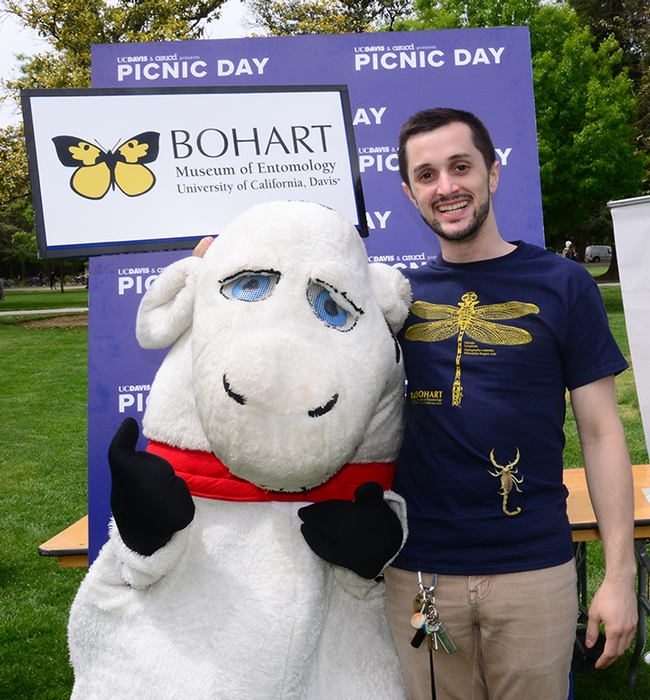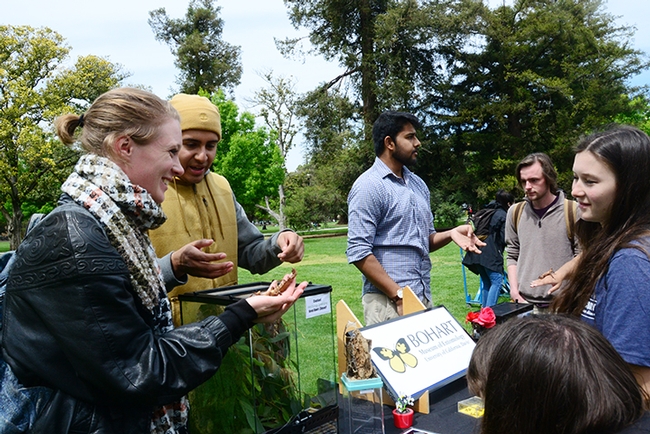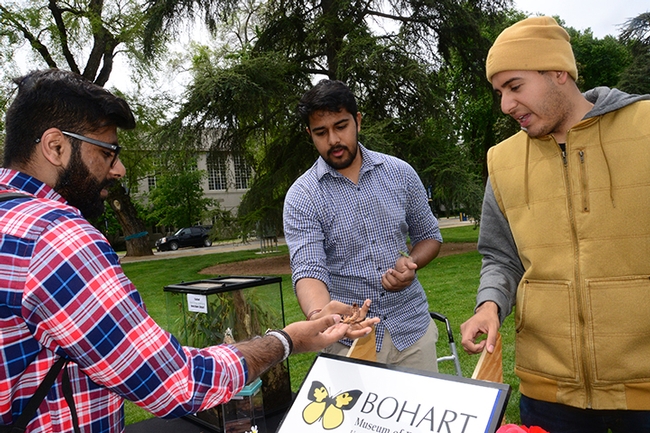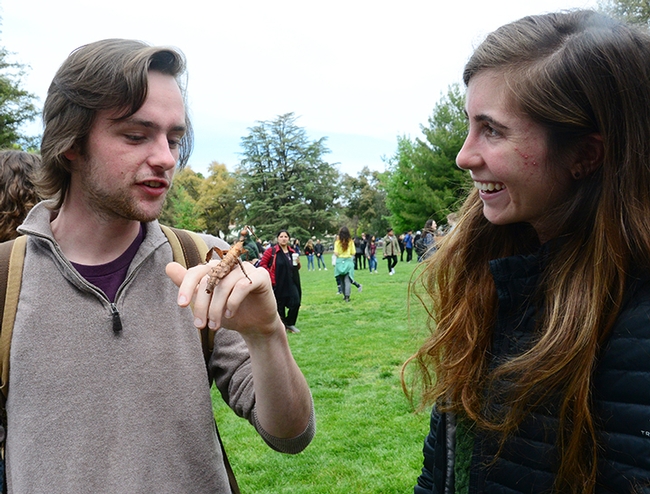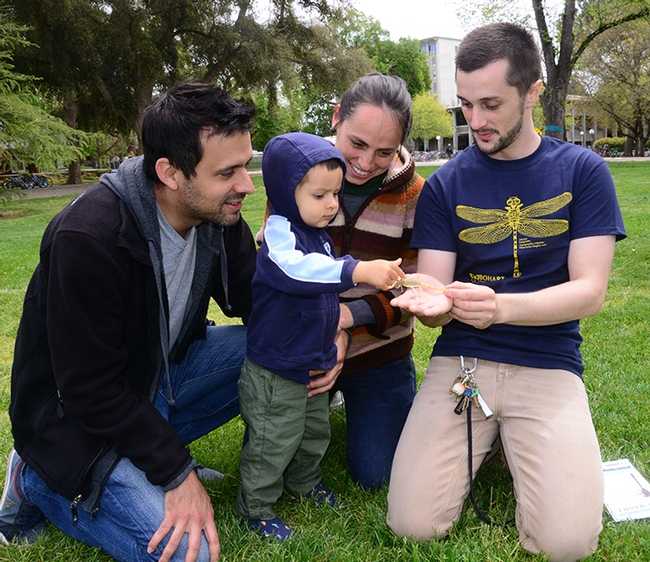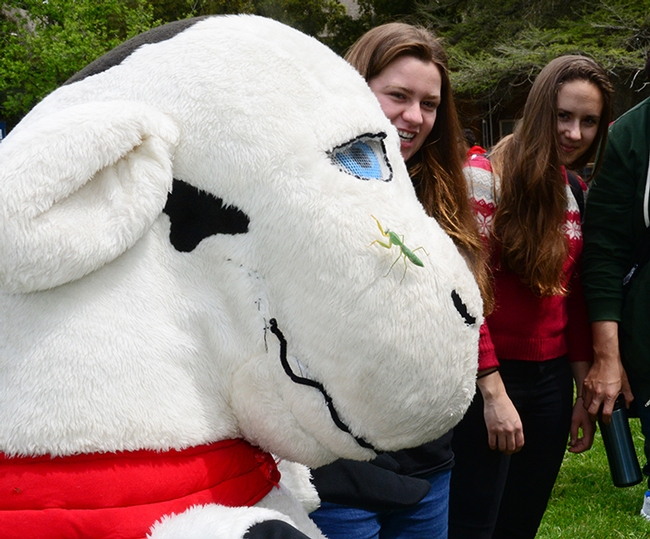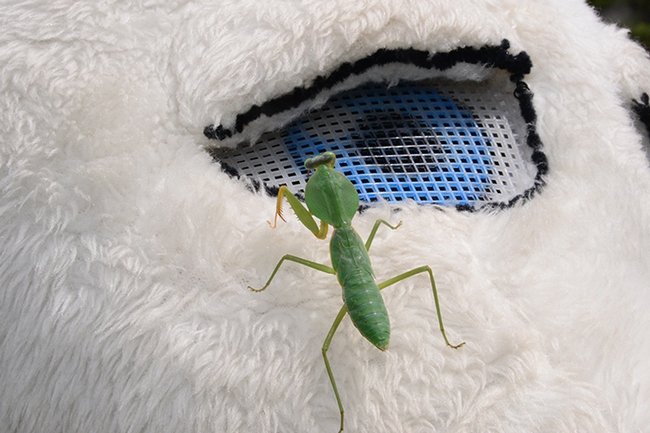- Author: Kathy Keatley Garvey
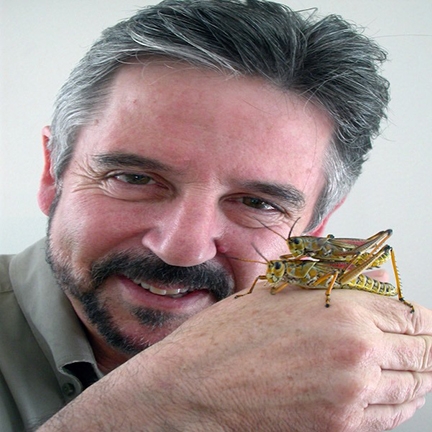
If you'd like to take a world tour and learn about such fascinating insects as darkling beetles, Australian walking sticks, giant African millipedes and others, be sure to sign up for the "Virtual Insect Palooza with the Insect Discovery Lab."
The program, open to all ages but limited to 25 participants, is set for 4 to 5 p.m., Friday, June 12 on Zoom, announced Norm Gershenz, chief executive officer and co-founder of the Bay Area-based SaveNature.Org. He also directs the organization's Insect Discovery Lab. He co-founded SaveNature.Org with wife Leslie Saul-Gershenz, a UC Davis scientist who holds a doctorate in entomology from the UC Davis Department of Entomology and Nematology.
"Professor Norm" will lead what is being billed as a "live, wild experience featuring arthropods from around the world." Viewers will be able to ask questions at the end of the program.
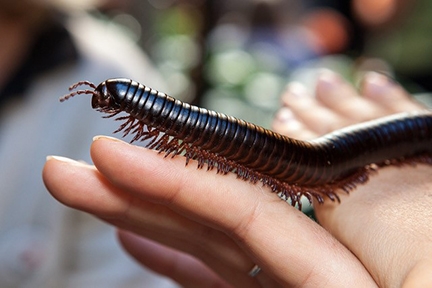
SaveNature.Org is an award-winning conservation organization which presents more than 800 educational outreach programs to some 38,000 children annually. National Geographic, Time magazine, and ABC's "World News Tonight" have all spotlighted the work.
Dedicated to international conservation, SaveNature.Org has raised more than $4.7 million to help preserve thousands of acres of rain forest, coral reef and desert habitat around the world, said Gershenz, who created and developed the first Adopt-an-Acre program in the United States, as well as the award-winning Conservation Parking Meter.
His credentials include 18 years with the San Francisco Zoo as an educator, member of the animal care staff, fundraiser, and researcher. In addition, he has worked as a field biologist and naturalist in Borneo, Malaysia, India, Nepal, Costa Rica and Namibia. "I have tracked black rhinos in Zimbabwe, chased orangutans in Borneo, and stalked the elusive platypus in Australia (with his camera)," he related. In his conservation work, he has handled boas and bobcats, pandas and elephants, snow leopards and koalas, hippos and hornbills.
In 2010, Gershenz received the prestigious Elizabeth Terwilliger Prize for Conservation. In 2018 the American Association of Zookeepers presented him with the Lifetime Achievement Award for outstanding work in nature conservation.
Resources:
SaveNature.Org website
SaveNature.Org Facebook
YouTube Video of Insect Discovery Lab
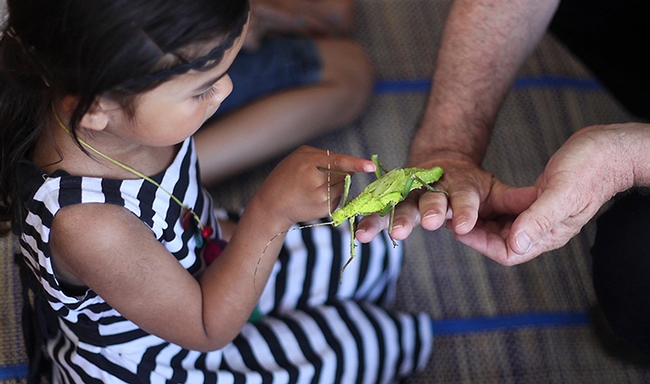
- Author: Kathy Keatley Garvey
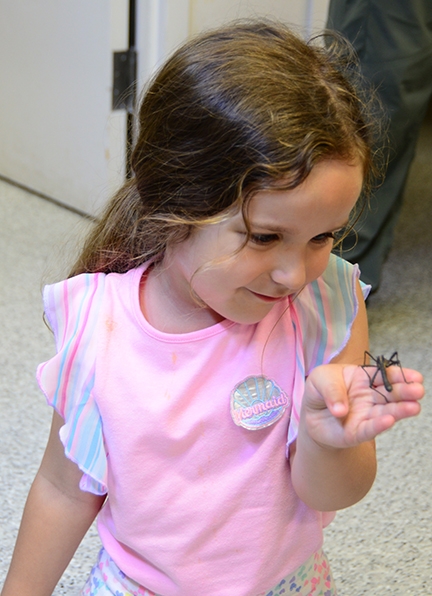
And this one, too.
And that one over there!
When UC Davis employees and their offspring visited the Bohart Museum of Entomology during the recent "Take Your Daughters and Sons to Work" Day, reactions ranged from awe to "wow!"
They held walking sticks (stick insects), Madagascar hissing cockroaches and tomato hornworms. Two youngsters held tarantulas. And all checked out the butterfly and beetle specimens.
One little girl, Olivia Bingen, 4, who was there with her father, Steve Bingen of the UC Davis Department of Music, was dressed in pink and asked the Bohart scientists if they had any pink butterflies.
"She likes pink," her father said. She also likes to play the violin.
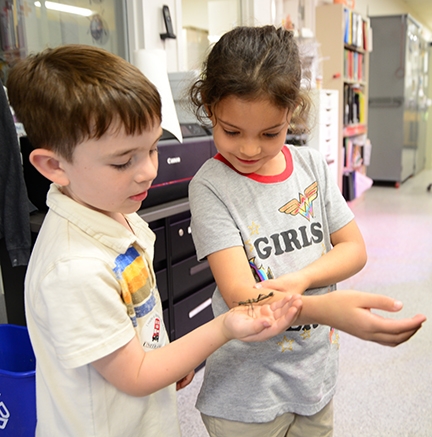
The museum, founded in 1946 by the late Richard M. Bohart and now directed by Lynn Kimsey, UC Davis professor of entomology, is open to the public from 9 a.m. to noon and from 1 to 5 p.m., Mondays through Fridays, except on holidays. Admission is free.
Special weekend events, free and family friendly, are held throughout the year. The next weekend event is Moth Night from 8 p.m. to 11 p.m. on Saturday, Aug. 3. Blacklighting will take place just outside the museum. Inside, the attendees will visit the museum's displays and, outside, they will see what insects are attracted to the black-lighted white sheets.
Among those scheduled to host Moth Night are John "Moth Man" DeBenedictis; senior museum scientist Steve Heydon; entomologist Jeff Smith, who curates the Lepitopdera (butterflies and moths) section of the Bohart; and Greg Kareofelas, Bohart associate and naturalist.
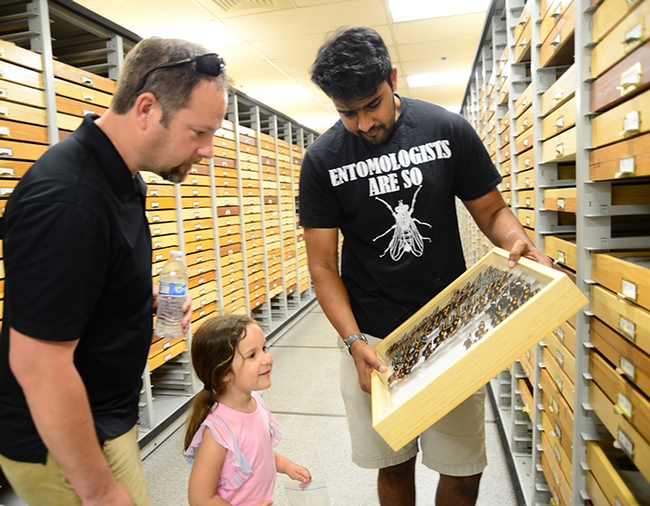
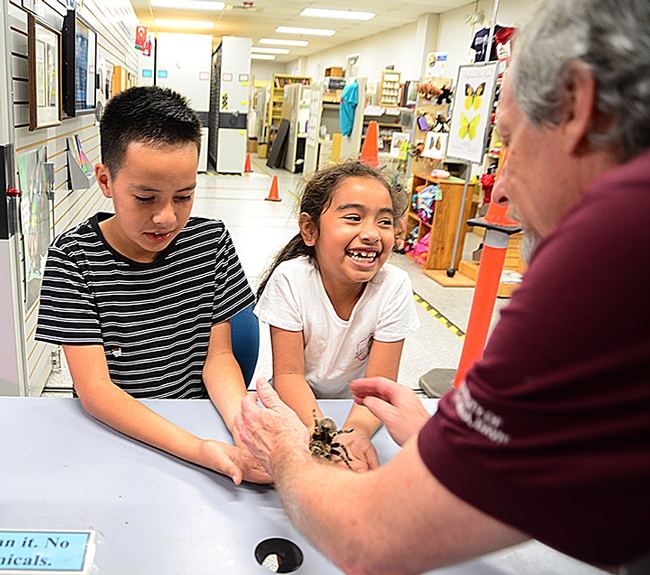
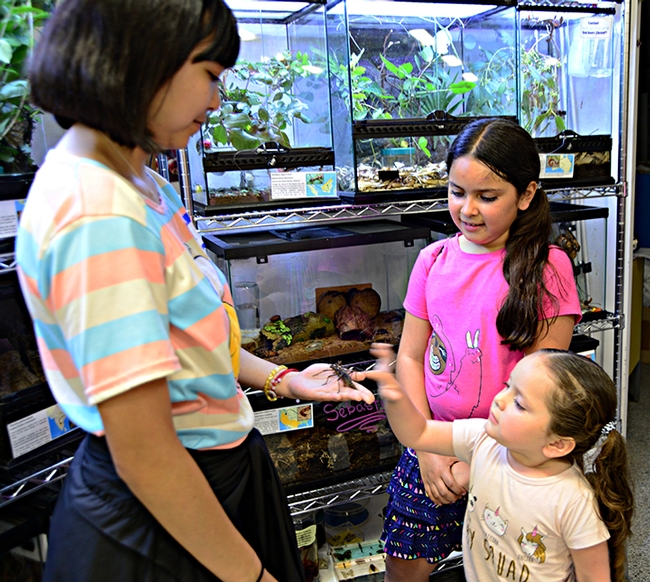
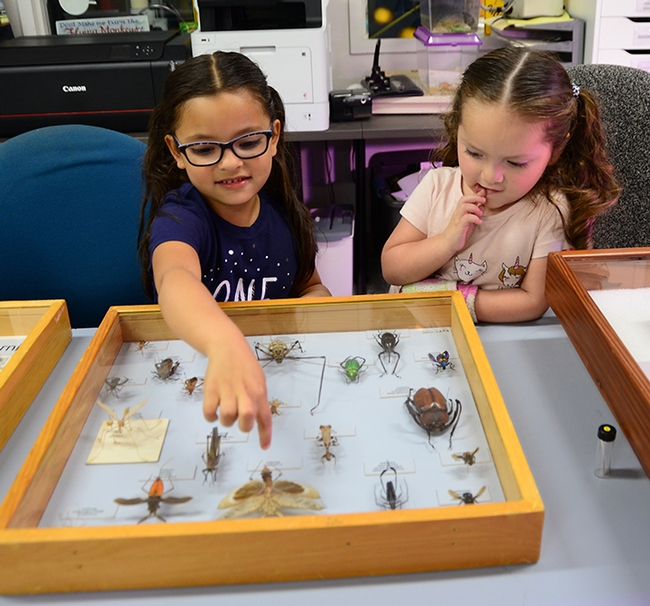
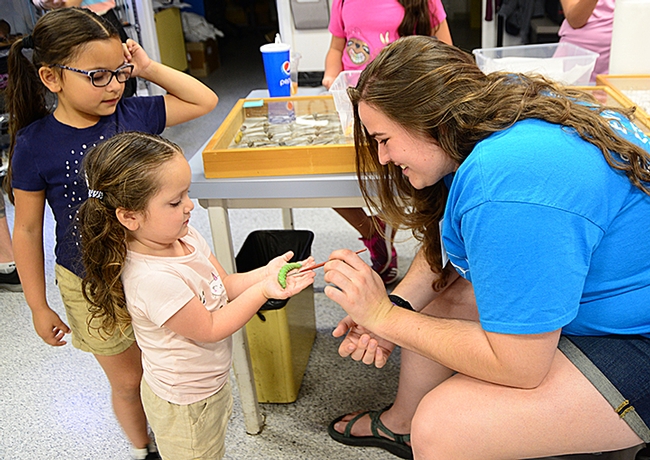
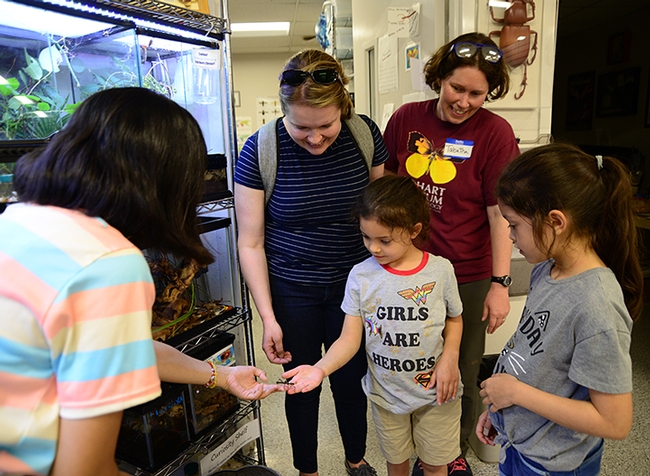
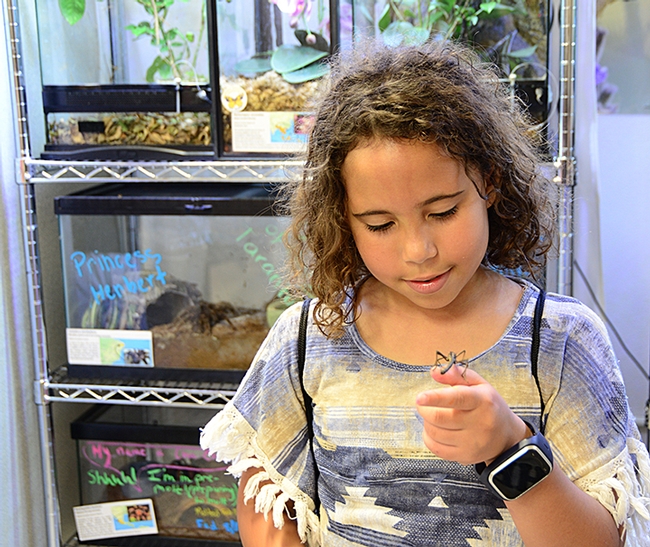
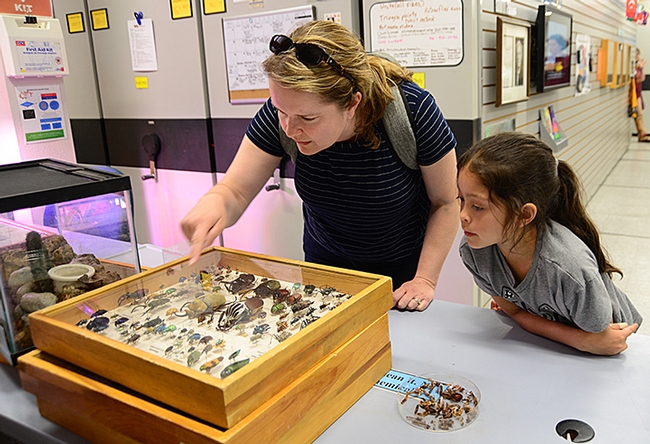
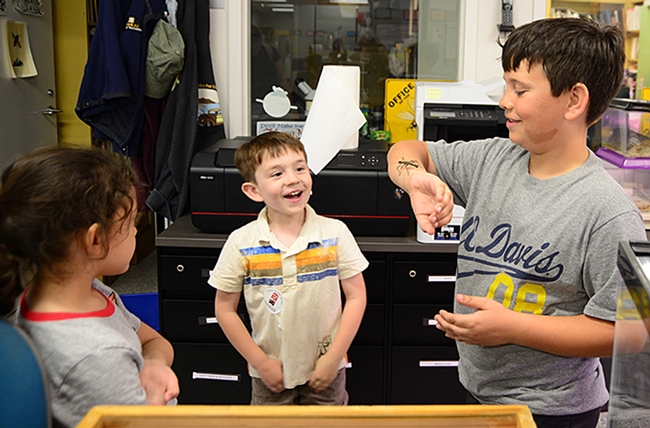
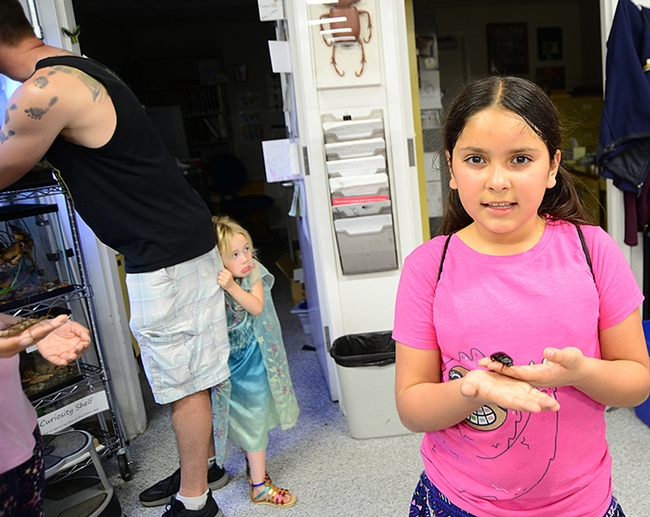
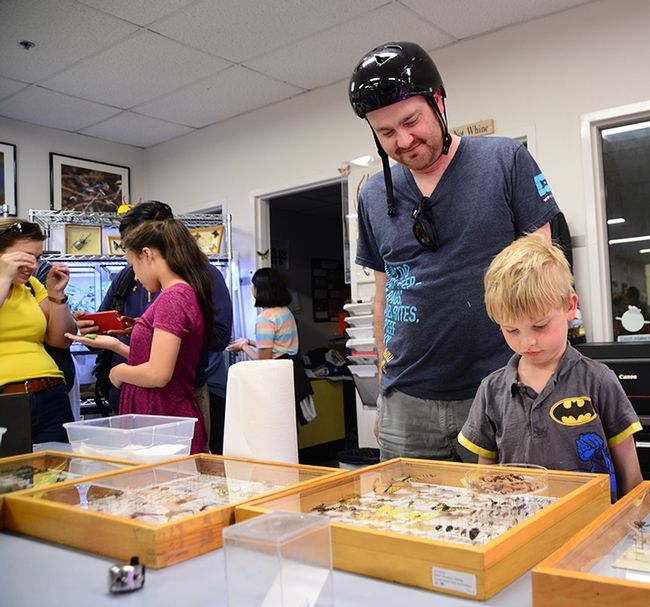
- Author: Kathy Keatley Garvey
It's finals week at the University of California, Davis, and what a great opportunity to take time to de-stress...with bugs!
Wade Spencer, entomology student and associate at the Bohart Museum of Entomology, says that students studying in the UC Davis LGBTQUIA Resource Center at 397 Hutchison Drive on Tuesday, March 19, will be sharing their space with bugs, including Coco McFluffin, a Chaco golden knee tarantula that makes its home in the Bohart Museum of Entomology. The Bohart Museum, located in Room 1124 of the Academic Surge Building on Crocker Lane, houses a global collection of nearly eight million insect specimens--AND a live petting zoo of dozens of critters, ranging from Madagascar hissing cockroaches to stick insects to tarantulas.
Billed as the "Finals-Week Bug Meet-n-Greet De-Stressor," the event takes place from noon to 1 p.m. in partnership with LGBTQUIA and the Bohart Museum.
The visitors include Coco McFluffin, Lucy the Gooty and Captain Mar-Vel. Here's who's on tap:
- Thorny Walking Sticks: https://species.wikimedia.org/wiki/Aretaon
- Australian Stick Insects: https://en.wikipedia.org/wiki/Extatosoma_tiaratum
- Vietnamese Stick Insects: https://en.wikipedia.org/wiki/Medauroidea_extradentata
- Giant Cave Cockroaches: https://en.wikipedia.org/wiki/Blaberus_giganteus
- Chaco Golden Knee Tarantula (Coco McFluffin): https://en.wikipedia.org/wiki/Grammostola_pulchripes
- Western Black Widow (Karen): https://en.wikipedia.org/wiki/Latrodectus_hesperus
- Multi-colored Centipede (Sebastian): https://en.wikipedia.org/wiki/Scolopendra_polymorpha
- Desert Hairy Scorpion (Celeste): https://en.wikipedia.org/wiki/Hadrurus_arizonensis
- Asian Forest Scorpion (Scotty): https://en.wikipedia.org/wiki/Heterometrus
- African Yellow-Legged Burrowing Scorpion (yet unnamed): https://en.wikipedia.org/wiki/Opistophthalmus_glabrifrons
- Sapphire Gooty Tarantula (Lucy the Gooty): https://en.wikipedia.org/wiki/Poecilotheria_metallica#Description
- And...Wade Spencer's tiny Arizona burrowing scorpion (Captain Mar-Vel): "I don't know the scientific name of her yet and can't seem to find any info online. But she's cute and tiny!"
"It should be noted," Spencer said, "that the only venomous arthropod that will be up for touching/holding will be Coco."
Study on!
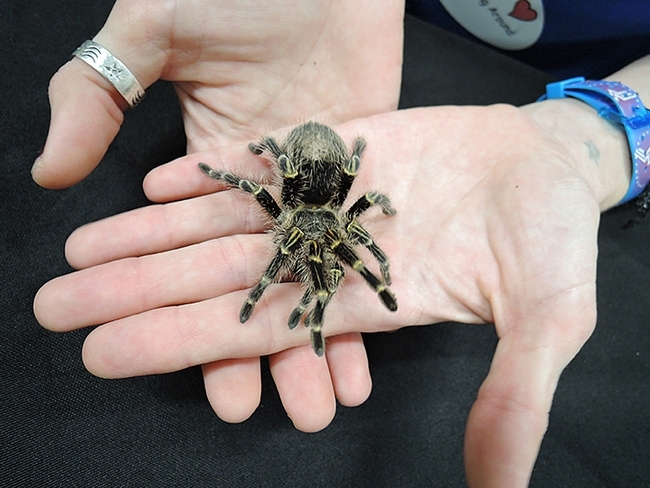
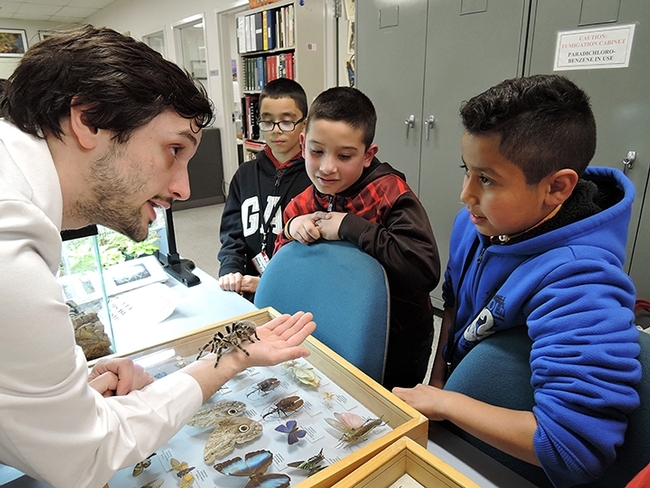
- Author: Kathy Keatley Garvey
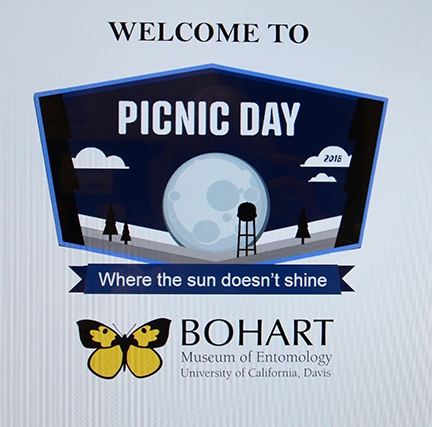
Who wouldn't, when you get an opportunity to pet a rose-haired tarantula named Snuggles, guide walking sticks "strolling" on your arm, or cradle a Madagascar hissing cockroach? Or marvel at the display of Platypsyllus castoris, an ectoparasite of beavers?
That's what awaited the 2000 visitors at the Bohart Museum of Entomology during the 104th annual UC Davis Picnic Day last Saturday, April 18.
Although the theme of the campuswide Picnic Day spanned "Where the Sun Shines," Bohart Museum officials focused on "Where the Sun Doesn't Shine." They highlighted nocturnal insects, cave-dwelling insects, and parasites, including a beetle, Platypsyllus castoris, found on the south end of a beaver.
Lynn Kimsey, director of the Bohart and professor of entomology at UC Davis, kept busy answering questions about the beaver display--a pelt, and a graphic of the beetle.
As Bohart Museum associate and undergraduate entomology student Wade Spencer said: "These beetles look like they are to fleas what halibut are to other fishes. Instead of the lateral compression fleas exhibit, Platyspyllus castoris are dorso-ventrally flattened, which only adds to their alien appearance. Their unique feeding and lodging preferences have given us so many good laughs, we wanted to make them the star of this year's picnic day event at the Bohart."
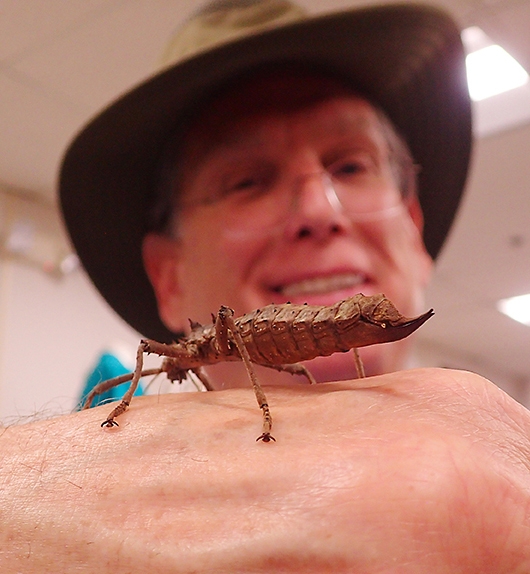
Entomologist Jeff Smith, who curates the butterfly and moth collection at the Bohart, kept busy encouraging visitors to get acquainted with Snuggles. They held him, petted him and photographed him. Little Teddy Owens, 2 of Davis, held by his mother, Dina, high-fived Snuggles.
Another display featured scorpions: graduate student Charlotte Herbert shone a black light on them to illustrate how they glow in the dark. All scorpions fluoresce in ultraviolet light.
Visitors also learned about bees in a display featuring sweat bees, leaf-cutting bees, mason bees, bumble bees, honey bees, sunflower bees, and carpenter bees, as well as Andrena and Melissodes anthophora.
The Bohart Museum houses a global collection of nearly eight million specimens. It is the home of the seventh largest insect collection in North America, and the California Insect Survey, a storehouse of the insect biodiversity. Special attractions include a “live” petting zoo, featuring Madagascar hissing cockroaches, walking sticks, praying mantids and tarantulas. The museum's gift shop, open year around, offers T-shirts, sweatshirts, books, jewelry, posters, insect-collecting equipment and insect-themed candy.
The Bohart Museum is open to the public from 9 a.m. to noon and 1 to 5 p.m. Mondays through Thursdays. It is closed to the public on Fridays, Saturdays and Sundays and on major holidays. Admission is free.
More information on the Bohart Museum is available by contacting (530) 752-0493 or emailing bmuseum@ucdavis.edu or Tabatha Yang at tabyang@ucdavis.edu.
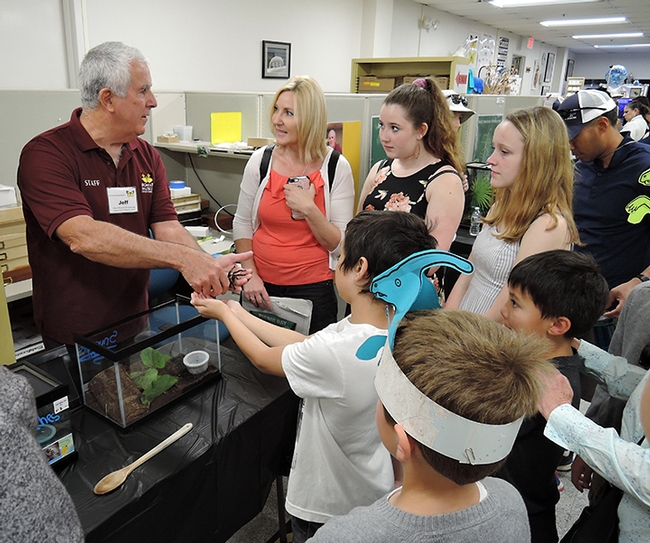

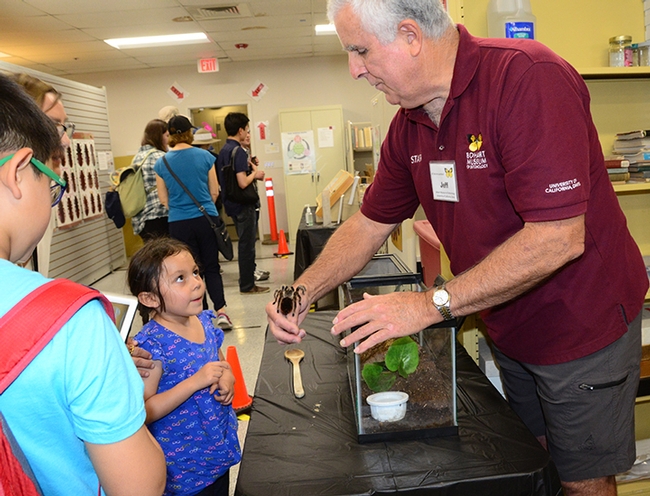
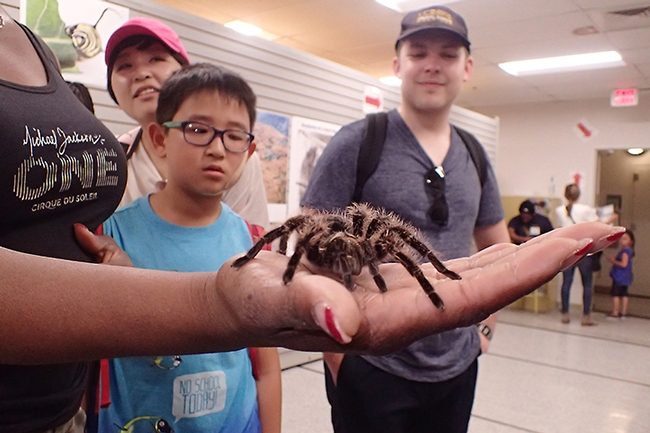
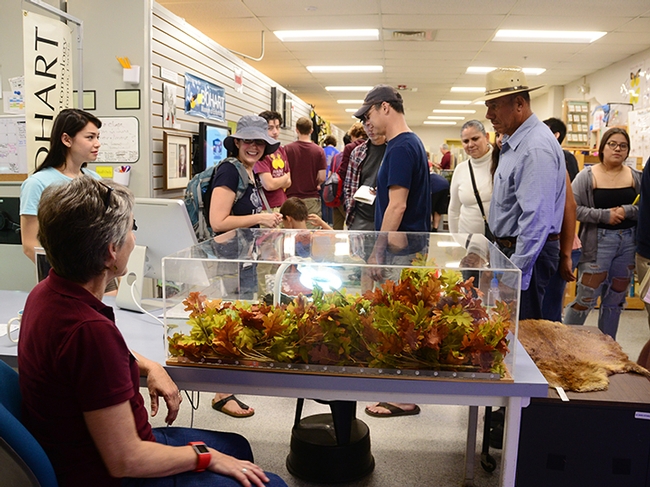
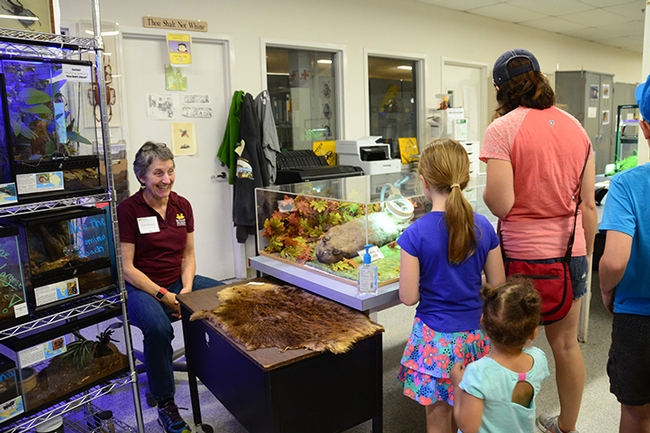
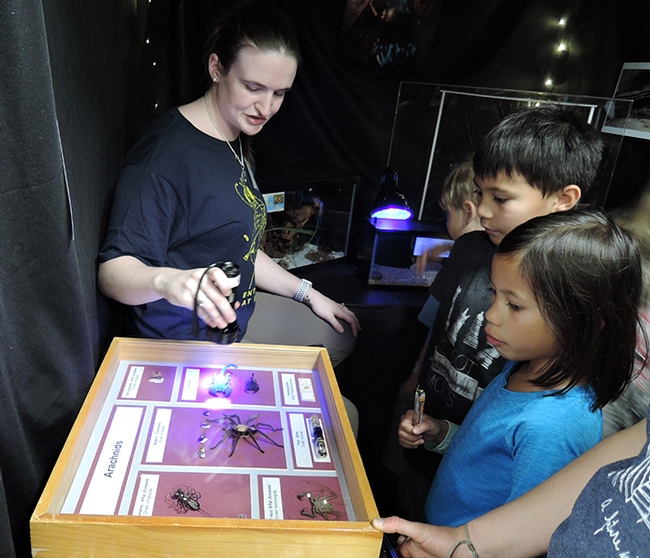
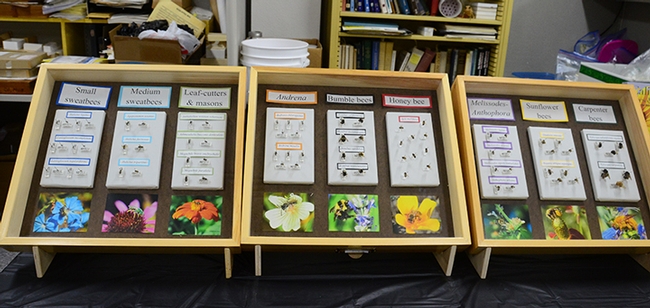
- Author: Kathy Keatley Garvey
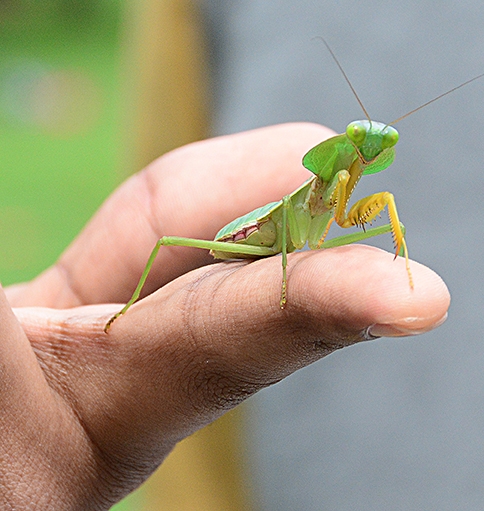
Well, UC Davis officials and the UC Davis Department of Entomology and Nematology did!
Yes!
All systems are "go" for the 104th annual UC Davis Picnic Day, an all-day event on Saturday, April 21 when scores of visitors, aka picnickers, will stroll the campus. It promises to be both educational and entertaining.
The UC Davis Picnic Day Committee offered a pre-view Thursday noon at the Quad.
Bohart Museum of Entomology representatives--Wade Spencer, Lohit Garikipati, and Diego Rivera, all UC Davis students and Bohart associates--kept busy answers questions about scorpions, stick insects and praying mantids.
Spencer displayed his desert hairy scorpion named Celeste. Okay, surprise, surprise! Celeste turned out to be a male, but his name remains Celeste.
Lohit Garikipati, an entomology student who rears praying mantids, came with his buddy, a Malaysian shield mantis. "What's that?" visitors asked, looking at the shield.
For a hour, the trio entertained the guests. Some expressed awe at Spencer casually holding a scorpion. "I've been handling scorpions since I was three," he said. "I've never been stung."
Rivera showed an Australian leaf walking stick insect that resembled a leaf. The crowd took turns holding and photographing it.
Now it's showtime!
On Saturday, April 21, during the campuswide Picnic Day, you can engage with insects at both Briggs Hall, which houses the Department of Entomology and Nematology administration and most of the faculty, and the Bohart Museum of Entomology, home of eight million insect specimens.
At Briggs Hall, located off Kleiber Hall Drive, activities will take place from 9 a.m. to 4 or 5 p.m. At the Bohart Museum of Entomology, located in Room 1124 of the Academic Surge Building on Crocker Lane, the open house is from 10 to 3 p.m.
Here's what's on tap at Briggs, either in front or inside the building:
- Entomology at UC Davis: Enter Briggs Hall and find a wide variety of entomology-themed displays, from classics, including insect forestry to recent additions, such as “Virtual Reality Bugs."
- Honey Tasting Booth: Extension apiculturist Elina Lastro Niño and her staff will operate the honey tasting booth, focusing on berry honeys. They will offer these honey varietals: blackberry, blueberry, raspberry, snowberry, almond and buckwheat.
- Maggot Art: Visitors will create maggot art by dipping a maggot into a water-based, non-toxic paint and position it on paper and let it crawl. Voila! Maggot art, suitable for framing
- Cockroach Races: Crowds can pick their favorite "roach athlete" and cheer it to victory
- Virtual Reality Bugs: Medical entomologist Geoffrey Attardo will set up a virtual reality system to enable people to view three dimensional models of insects. In VR, the models can be made to look life size, 40 feet tall or anywhere in between, he says. Here's the link that to view them in your web browser: https://skfb.ly/6xVru
- Bug Doctor: The Doctor Is In: Graduate students will identify insects and arachnids and answer questions
- IPM Booth: UC Statewide Integrated Pest Management Program professionals will discuss and answer questions about insect pests, beneficial insects and pest control. They will display their publications and live insects. In keeping with tradition, they will give away free lady beetles (lady bugs), to be released in gardens to devour aphids and other soft-bodied insects.
- Mosquito Abatement: Sacramento-Yolo Mosquito and Vector Control District professionals will staff a booth
- Dr. Death: Forensic entomologist Robert Kimsey will staff his traditional Dr. Death booth, inviting the visitors to ask questions and look through microscopes.
- Davis Fly Fishers: The anglers will demonstrate fly-tying techniques in Briggs 158
- Scavenger Hunt: Participants will search for and identify insects in a display of 10 drawers in Briggs 122.
- Insect Face Painting: Entomology Club members will face-paint bees, butterflies, lady beetles and other insects
- T-Shirt Sales: Visitors can take their pick or picks among insect-themed t-shirts (popular t-shirts include beetles and honey bees) Selection and prices are online at https://mkt.com/UCDavisEntGrad/
- Bake Sale: The Entomology Club will offer insect-themed baked goods.
- Strike Up the Band: Music composed by Michael Lewis Bollinger (Frank Zalom lab); cover songs possible. The band, dressed in insect costumes, will include Jackson Audley of the Steve Seybold lab, rhythm guitar; Yao Cai of the Joanna Chiu lab, drums; Christine Tabuloc of the Chiu lab, vocals; Zachary Griebenow of the Phil Ward lab, keyboard; Wei Lin of the Brian Johnson lab, bass; Jill Oberski of the Phil Ward lab, tenor saxophone; and Brendon Boudinot of the Phil Ward lab, bassist.
"The band will be setting up and warming up at 4," said Boudinot. "We'll start our set at 4:30, and wrap up at 5 or so. We are working on tightening up the set list--for now we have four songs. Expect some guitar and drum solos at the least!"
Bohart Museum
At the Bohart Museum, open from 10 a.m. to 3 p.m., the theme is "Where the Sun Doesn't Shine," a play on this year's Picnic Day theme of "Where the Sun Shines."
"We'll be highlighting nocturnal insects, cave dwelling insects, and yes, beaver butt beetles or Platypsyllus castoris, an ectoparasite on beavers, near their glands, wounds, and skin," said Tabatha Yang, education and outreach coordinator. " We will be holding insects as well."
The Bohart Museum will also showcase its live "petting zoo," comprised of Madagascar hissing cockroaches, walking sticks or stick insects, tarantulas and mantids. The museum also offers a year-around gift shop with T-shirts, jewelry, posters, books, insect nets and the like.
"Entomology at UC Davis" (122 Briggs) has been nominated for a special campus award under the category "At One With Nature." The Honey Tasting booth at Briggs has been nominated for a similar award under the category, “Hunger Fix.” Winners of the categories are determined by an Internet vote. (Access the link here to vote from 8 a.m. to 10 p.m. for your favorite exhibits on Picnic Day). The winners will be publicized on the Picnic Day website, Facebook, Twitter, Instagram, and Snapchat accounts after Picnic Day.
What's a picnic without bugs?
